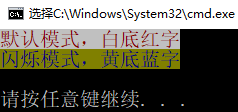如何用Python的标准print函数打印一个彩色的围棋局面?
尽管print函数是初学者最先接触到的第一个Python标准函数,但很多人并没有真正了解它。我曾经在《用 print() 函数实现的三个特效》一文中展示了print函数的一些实用技巧,受到读者热捧。今天,我再给大家介绍print函数的另一个技巧:打印彩色文字和图案,并在最后定义一个打印围棋局面的函数,可以打印出下图这样的效果。
毕竟是在文本模式下,print函数支持的彩色比较少,只有8种,如下表所示。
| 前景代码 | 背景代码 | 颜色 |
|---|---|---|
| 30 | 40 | 黑 |
| 31 | 41 | 红 |
| 32 | 42 | 绿 |
| 33 | 43 | 黄 |
| 34 | 44 | 蓝 |
| 35 | 45 | 紫 |
| 36 | 46 | 青 |
| 37 | 47 | 白 |
print支持以下几种显示模式:
- 0 - 默认
- 1 - 高亮
- 4 - 下划线
- 5 - 闪烁
- 7 - 反白
- 8 - 隐藏
- 22 - 去高亮
- 24 - 去下划线
- 25 - 去闪烁
- 27 - 去反白
- 28 - 去隐藏
使用print函数打印彩色文字或图案时,每一行以前缀“\033[”开始,其后紧跟显示模式、前景色和背景色,三者中间以分号分割,后接小写字母“m”。在显示内容之后,一般以后缀“\033[0m”结束。
print("\033[0;31;47m" + "默认模式,白底红字" + "\033[0m")
print("\033[5;34;43m" + "闪烁模式,黄底蓝字" + "\033[0m")
不过,如果你是在Windows环境中运行的话,估计不会出现这个期望的结果。我猜测这应该是Python的一个非常古怪且难以解决的bug,从Py2时代就一直如此。解决方案也很奇葩,使用os模块的system函数运行一次空命令就OK了。代码如下:
import os
os.system('')
print("\033[0;31;47m" + "默认模式,白底红字" + "\033[0m")
print("\033[5;34;43m" + "闪烁模式,黄底蓝字" + "\033[0m")
好,讲完了预备知识,是时候打印一个彩色的围棋局面了。我们约定围棋局面用一个二维的NumPy数组来表示。黑子、白子、和空,我们分别用Unicode字符集中的0x25cf、0x25cb、和0x253c来表示,边角也使用各自的对应符号。这个符号,我们可以在IDLE中直观地显示。
>>> chr(0x25cf)
'●'
>>> chr(0x25cb)
'○'
>>> chr(0x253c)
'┼'
>>> chr(0x250c)
'┌'
>>> chr(0x2510)
'┐'
接下来,应用上面这些知识点,就可以写出一个打印围棋局面的函数了。
import numpy as np
import os
os.system('')
def show_phase(phase):
"""显示局面"""
for i in range(19):
for j in range(19):
if phase[i,j] == 1:
chessman = chr(0x25cf)
elif phase[i,j] == 2:
chessman = chr(0x25cb)
elif phase[i,j] == 9:
chessman = chr(0x2606)
else:
if i == 0:
if j == 0:
chessman = '%s '%chr(0x250c)
elif j == 18:
chessman = '%s '%chr(0x2510)
else:
chessman = '%s '%chr(0x252c)
elif i == 18:
if j == 0:
chessman = '%s '%chr(0x2514)
elif j == 18:
chessman = '%s '%chr(0x2518)
else:
chessman = '%s '%chr(0x2534)
elif j == 0:
chessman = '%s '%chr(0x251c)
elif j == 18:
chessman = '%s '%chr(0x2524)
else:
chessman = '%s '%chr(0x253c)
print('\033[0;30;43m' + chessman + '\033[0m', end='')
print()
if __name__ == '__main__':
phase = np.array([
[0,0,2,1,1,0,1,1,1,2,0,2,0,2,1,0,1,0,0],
[0,0,2,1,0,1,1,1,2,0,2,0,2,2,1,1,1,0,0],
[0,0,2,1,1,0,0,1,2,2,0,2,0,2,1,0,1,0,0],
[0,2,1,0,1,1,0,1,2,0,2,2,2,0,2,1,0,1,0],
[0,2,1,1,0,1,1,2,2,2,2,0,0,2,2,1,0,1,0],
[0,0,2,1,1,1,1,2,0,2,0,2,0,0,2,1,0,0,0],
[0,0,2,2,2,2,1,2,2,0,0,0,0,0,2,1,0,0,0],
[2,2,2,0,0,0,2,1,1,2,0,2,0,0,2,1,0,0,0],
[1,1,2,0,0,0,2,2,1,2,0,0,0,0,2,1,0,0,0],
[1,0,1,2,0,2,1,1,1,1,2,2,2,0,2,1,1,1,1],
[0,1,1,2,0,2,1,0,0,0,1,2,0,2,2,1,0,0,1],
[1,1,2,2,2,2,2,1,0,0,1,2,2,0,2,1,0,0,0],
[2,2,0,2,2,0,2,1,0,0,1,2,0,2,2,2,1,0,0],
[0,2,0,0,0,0,2,1,0,1,1,2,2,0,2,1,0,0,0],
[0,2,0,0,0,2,1,0,0,1,0,1,1,2,2,1,0,0,0],
[0,0,2,0,2,2,1,1,1,1,0,1,0,1,1,0,0,0,0],
[0,2,2,0,2,1,0,0,0,0,1,0,0,0,0,1,1,0,0],
[0,0,2,0,2,1,0,1,1,0,0,1,0,1,0,1,0,0,0],
[0,0,0,2,1,1,0,0,0,0,0,0,0,0,1,0,0,0,0]
], dtype=np.ubyte)
show_phase(phase)

